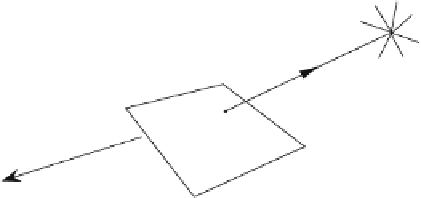Graphics Reference
In-Depth Information
Y
L
L
P
X
Z
Figure 10.1.
In physics, two models are used to describe light: corpuscular and waves. The corpuscular
model assumes that light is made up of small packets of electromagnetic energy called photons,
which move at the speed of light. This is a convenient model to use when trying to understand
the intensity of an illuminated surface. For example, when we observe an illuminated surface,
its intensity is determined by the number of photons we perceive per unit surface area. The
more photons detected, the more intense the surface appears. Imagine, then, a matte surface
illuminated by a point light source, as shown in Fig. 10.2. Photons striking the surface are
reflected back equally in all directions due to the random nature of the surface geometry.
L
n
A
θ
θ
C
B
Figure 10.2.
If the line AB represents the diameter of a 3D circle, and the line CB represents the diameter
of a 3D circle on the matte surface, then the number of photons n per unit area striking CB is
proportional to
AB
CB
n
∝
But from Fig. 10.2, we have
AB
CB
=
cos

















